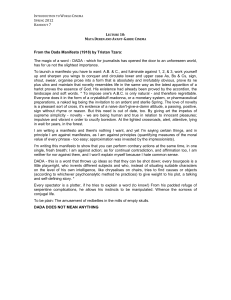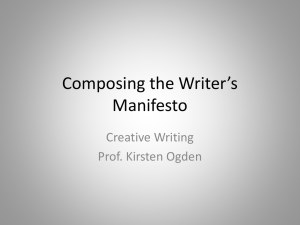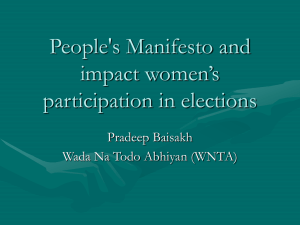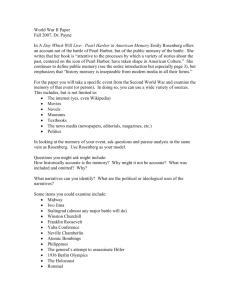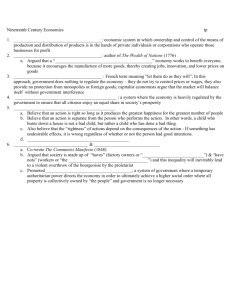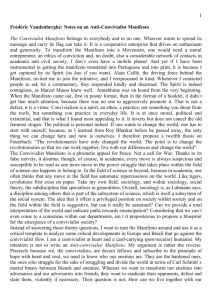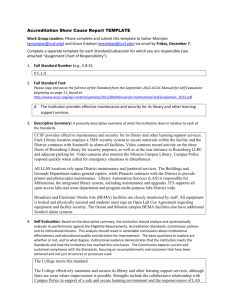European Journal of English Studies
advertisement
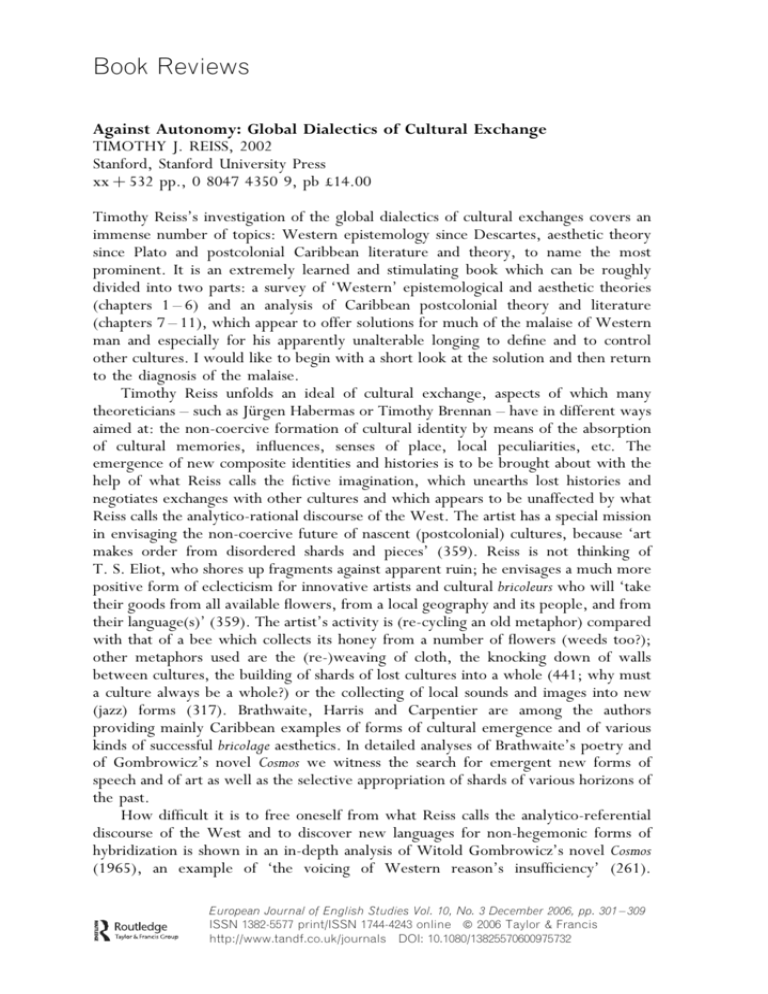
Book Reviews Against Autonomy: Global Dialectics of Cultural Exchange TIMOTHY J. REISS, 2002 Stanford, Stanford University Press xx þ 532 pp., 0 8047 4350 9, pb £14.00 Timothy Reiss’s investigation of the global dialectics of cultural exchanges covers an immense number of topics: Western epistemology since Descartes, aesthetic theory since Plato and postcolonial Caribbean literature and theory, to name the most prominent. It is an extremely learned and stimulating book which can be roughly divided into two parts: a survey of ‘Western’ epistemological and aesthetic theories (chapters 1 – 6) and an analysis of Caribbean postcolonial theory and literature (chapters 7 – 11), which appear to offer solutions for much of the malaise of Western man and especially for his apparently unalterable longing to define and to control other cultures. I would like to begin with a short look at the solution and then return to the diagnosis of the malaise. Timothy Reiss unfolds an ideal of cultural exchange, aspects of which many theoreticians – such as Jürgen Habermas or Timothy Brennan – have in different ways aimed at: the non-coercive formation of cultural identity by means of the absorption of cultural memories, influences, senses of place, local peculiarities, etc. The emergence of new composite identities and histories is to be brought about with the help of what Reiss calls the fictive imagination, which unearths lost histories and negotiates exchanges with other cultures and which appears to be unaffected by what Reiss calls the analytico-rational discourse of the West. The artist has a special mission in envisaging the non-coercive future of nascent (postcolonial) cultures, because ‘art makes order from disordered shards and pieces’ (359). Reiss is not thinking of T. S. Eliot, who shores up fragments against apparent ruin; he envisages a much more positive form of eclecticism for innovative artists and cultural bricoleurs who will ‘take their goods from all available flowers, from a local geography and its people, and from their language(s)’ (359). The artist’s activity is (re-cycling an old metaphor) compared with that of a bee which collects its honey from a number of flowers (weeds too?); other metaphors used are the (re-)weaving of cloth, the knocking down of walls between cultures, the building of shards of lost cultures into a whole (441; why must a culture always be a whole?) or the collecting of local sounds and images into new (jazz) forms (317). Brathwaite, Harris and Carpentier are among the authors providing mainly Caribbean examples of forms of cultural emergence and of various kinds of successful bricolage aesthetics. In detailed analyses of Brathwaite’s poetry and of Gombrowicz’s novel Cosmos we witness the search for emergent new forms of speech and of art as well as the selective appropriation of shards of various horizons of the past. How difficult it is to free oneself from what Reiss calls the analytico-referential discourse of the West and to discover new languages for non-hegemonic forms of hybridization is shown in an in-depth analysis of Witold Gombrowicz’s novel Cosmos (1965), an example of ‘the voicing of Western reason’s insufficiency’ (261). European Journal of English Studies Vol. 10, No. 3 December 2006, pp. 301 – 309 ISSN 1382-5577 print/ISSN 1744-4243 online ª 2006 Taylor & Francis http://www.tandf.co.uk/journals DOI: 10.1080/13825570600975732 302 EUROPEAN JOURNAL OF ENGLISH STUDIES Gombrowicz is introduced as a dislocated Polish voice speaking largely from Argentina. Cosmos shows the artist’s difficulties with Western concepts of realism and representation and the concomitant unsettling of language, the taking over of opaque imagery and the failure of syntactic order, thus leading to dispersion, loss and dissemination, and moving finally to the reversal of speech into nonsense. The exploration of the limits of semiosis and reference is compared with Virginia Woolf’s use of polysemous symbols, which in To the Lighthouse explore a breach between male assertive certitudes and female toleration of confusion: whether there generally is a gendered subtext to the decentering of the analytico-referential discourse of the West remains in the dark, however. Cosmos is shown to be a deconstructive novel and poststructuralist ideas seem generally to inspire Reiss’s anatomy of postcolonial cultural bricolage. It seems that the utopian dimension of the emergence of new cultural identities-as-florilegia is not darkened by political or economic contexts, such as: Who tends the flowers? Are they wild or cultivated? Who buys/sells the honey? The scope of Reiss’s investigation is vast and the delineation of forms of poetic counter-discourses in the Caribbean is not the only focus: as mentioned above, the malaise of Western epistemologies and aesthetic categories, leading to the concepts of the autonomous subject and of autonomous art, is also investigated. The first chapters explore the cultural blight brought about by analytico-referential discourse, by the Cartesian mind/body-division and by aesthetic concepts of the tragic and of mimesis, which are made responsible for an aesthetics of autonomy. The main attack is directed at the autonomous individual, the concept of abstract reason and unalterable standards of judgement. Against these Enlightenment ideas Reiss offers a concept of embeddedness, of knowing oneself with others and of knowing others in their own embeddedness, finally leading to ‘interweaving cultural experiences and ways of seeing’ (67). In the context Tönnies’s rather dated binary concepts of Gemeinschaft vs Gesellschaft are repeatedly mentioned. It seems that, while celebrating diversity, Reiss tends to reify its ‘others’, the West, European culture and the Western concepts of tragedy and of mimesis. All mimesis aims, according to Reiss’s platonic view, to transcend the concrete reality in which we live, allowing us ‘to make the victim of imperial expansion into the other of aesthetic and political imagining’ (155). By unearthing a little-known text by Seneca, however, Reiss is able to cure the malaise of Western representation: it is here that he finds the image of the artist as bee, as a collector of various models and a creator of new forms. What M. H. Abrams once set forth as the opposition between the mirror and the lamp is then again explored with reference to traditional metaphors of inspiration. It appears, however, that within the Western literary traditions a poetics of inspiration and of bricolage has been singularly absent, and literature generally has become complicit with imperialist politics of appropriation and othering: Literature confirmed (sometimes complicated) politics of singular authority, however embodied; it claimed to be ordered by a syntax that was both that of right language and that of universal reason; it portrayed and asserted an ethics of individual interest whose virtue lay in simultaneously benefitting the community (302). REVIEWS It is in such sweeping statements that the limitations of this study become apparent: which literature is Reiss speaking of? Froude, Kipling, Orwell, Shakespeare, J. S. Mill, Gombrowicz or Woolf? Satire, utopia, historiography or poetry? Is there only one kind of European literature and only one language? Excellent as the interpretations of postcolonial texts in their diversity are, the statements concerning mimesis, tragedy or the West appear to apply exactly such binary coding to European concepts as are anathema for the periphery. Nevertheless this is an exciting and daring venture into the history of Western concepts of self and other and of aesthetic theory, which should create much debate in the fields of the history of philosophy, comparative cultural studies and postcolonial studies. It is to be regretted that the vast compass of Reiss investigations cannot be adequately covered in a short review like this one. WALTER GÖBEL, Universität Stuttgart, Germany Textual Subjectivity: The Encoding of Subjectivity in Medieval Narratives and Lyrics A. C. SPEARING, 2005, Oxford, Oxford University Press 273 pp., 0 19 818724 6, hb £50.00 A new book by A. C. Spearing is always an event. Perhaps that is because it can be guaranteed, like his earlier work, to explore with elegance and clarity current theoretical issues that seem to tie other writers up in knots, while offering us compelling and moving insights into the medieval works he so intimately engages with. Spearing casually strolls through the intricate pathways of current critical theory while never losing sight of what he himself calls ‘that primitive and indispensable goal of pleasure’. His wonderful readings of Medieval Dream-Poetry (1976) arguably conveyed the implications of self-reflexivity and of mise en abyme more effectively than did many a publication in the 1970s. His 1993 study of The Medieval Poet as Voyeur successfully mediated psychoanalytical and narratological theories of the gaze to readers otherwise resistant to them. In these and many other publications, this distinguished scholar has already amply demonstrated his familiarity with the first-person or ‘I’ of medieval writing. Yet in his latest study of Textual Subjectivity, the object of which is to explore the encoding of subjectivity in medieval narratives and lyrics, Spearing brings a new – perhaps defamiliarizing – twist to his previous reflections on this feature of the texts he scrutinizes. There is also a new tone of irritability discernible in the author’s disappointment with medievalists who fail to engage with current critical theory, as well as with critics who commit a variety of crimes relevant to the subject at hand, such as the failure to distinguish ‘voice’ from writing. For this distinction is essential to Spearing’s project of studying how the language of medieval literature encodes subjectivity. By associating the concept of subjectivity with that of textuality, he deftly steers clear of some of the explosive devices with which this critical field is mined. Thus his introduction outlines some of the prevalent (mis)conceptions about subjectivity that he does not entertain. His is not a book about subjectivity as 303 304 EUROPEAN JOURNAL OF ENGLISH STUDIES individuality (in the sense of emancipation from a group), nor is it about subjectivity as the expression of a self or of a (Cartesian) subject. It is not even about a text designating itself as a product of a particular consciousness prior to and outside of the text. All of these approaches to subjectivity posit its emergence at a specific point in historical time, but none of them elicits consensus about the historical conditions under which subjectivity emerged – proposals range from the twelfth to the seventeenth centuries. Spearing suggests that it is misguided to search for subjectivity outside its linguistic construction in written texts, where it is a function of a textuality that is (to a certain extent) independent of the writer who produced it. Although the readings that this volume affords are approximately arranged in chapters which suggest a historical progression from the twelfth to the fifteenth centuries, Spearing is less intent upon historicizing his texts than on alerting us to the encoded mechanisms by which the textual subject distances itself from the personal voice in which it was once biographically grounded. Before proceeding to study the purely textual phenomenon of subjectless subjectivity in writings from which the writer is somehow absent, he therefore needs to debunk a few myths about the relationship of the written to the spoken word, about twentieth-century phonocentric linguistic theory (which insists on the primacy of speech), and about the concomitant assumption that all narratives have narrators. It is something he does with evident relish, and most medievalists will take to heart the privileging of writing as a medium with a class of utterances peculiar to it and which do not exist elsewhere (Kittay) – a medium in which poets may speak as writers and construct textual selves out of fragments of other poets’ texts. For medievalists – as Spearing points out – are readers of stories that were traditionally seen as retellings of stories that had always already been there, existing objectively without any anchoring in personal perception. Medieval narratives were therefore somehow prior to their narrators, and although this priority only begins to be questioned by writers like Chaucer, it was pervasive enough throughout the period to alert us to the dangers of automatically associating texts with speakers and narratives with narrators. Lucid and leisurely, Spearing makes the formidable theoretical problems with which he engages seem simple – possibly simpler than they are. Therefore, it is probably less on account of its introductory theoretical reflections, and more on account of its superb readings that this book manages to persuade us that the construction through deixis of a single speaking subject is both an effect of textuality and a fiction. Spearing’s eloquent demonstration of how Robert Mannyng of Brunne becomes part of the historical text he composes (15 – 17) whets the appetite for the chapters to come. Indeed, even if there is some overlap with readings that Spearing has previously published elsewhere, there are some powerful, original and moving analyses of the texts he has selected for this volume. There is also a tendency in those chapters for Spearing to pick a quarrel with what he calls traditions of misreading. His chapter on Chaucer’s Troilus is a case in point. It is as much about the many misreadings of Troilus that have resulted from theories of a fallible or unreliable narrator as it is about Chaucer’s grand style, which authenticates the poetic vision it asserts. The Man of Law’s Tale (from the Canterbury Tales) has similarly suffered from persistent critical construction of its narrator as fallible, and the concomitant construction of the author as being beyond reproach. In these Chaucer chapters Spearing takes on a formidable array of distinguished critics, from Kittredge and REVIEWS Talbot Donaldson to Carolyn Dinshaw and Susan Schibanoff. I cannot help wondering whether the author’s cause is not better served by his generous textual analyses than by his all too frequent skirmishes with ‘the critics’ (‘I am tempted to turn the critics’ methods against themselves, and to read the ‘‘errors’’ in some of their writings as evidence that they use fallible narrators as means of exposing, hence questioning, the views ostensibly conveyed in their academic fictions’, 116). Be that as it may, there is much to learn and relish in his chapters on narratorial style in the early romances of Horn (where analogies with the medium of film allow Spearing to conclude that textual subjectivity ‘pervades the [narratorless narrative] without having any specific source or centre’, 48) and Havelok (whose poet moves ‘flexibly from one textual role to another as he tells his story’, 57). Where other readers of Havelok have associated the poem’s contradictory references to oral speech acts and to textuality with the uncertain conditions of its textual production and reception, Spearing relishes the gaps that these ambiguities open up between narrative and narrator, history and fiction. In addition to the chapters on the Pearl Poet, and on (Provençal and English) courtly Lyrics, there is a final chapter on epistolary poems, which concludes with a superb reading of the sequence of poems of MS Harley 682, generally attributed to Charles of Orleans. This sequence, deceptively suggestive of autobiographical narrative, is referred to by Spearing as The Duke’s Book, with reference to its ‘bookishness’ or – more important for his purpose – to its ‘writtenness’. The love poems’ many references to their own textuality set up a problematics of separation and absence (against a background of imprisonment) in which the first person is estranged from itself, a shifting and unstable self experienced as a fragmented text. In offering a reading of the poem’s progression as one in which the fictional lover or actual poet becomes ‘habituated to absence and writing as the only medium for love’ (246), Spearing is at his best. It is also the point at which this book on Textual Subjectivity has come full circle, returning – like The Duke’s Book – to reflect on the loss of the ‘metaphysics of presence’. Spearing could be evoking his own book when he refers to Charles’s ‘book as a whole, hovering between drama and miscellany, and exploring with precision and passion some emotional consequences of the fact that . . . poetry is made out of words and that its ‘‘I’’ and ‘‘you’’ mark not the presence but the absence of human subjects’ (247). Of Charles’s poetry it may indeed be said that ‘it is an achievement that deserves far more attention than it has received’ (ibid.). Of Spearing’s latest book it can surely be predicted that it will receive a great deal of attention, and that will be well deserved. MARGARET BRIDGES, Universität Bern, Switzerland The Poems and Plays of Isaac Rosenberg Edited by VIVIEN NOAKES, 2004, Oxford, Oxford University Press xxxv þ 427 pp., 0 19 818715 7, hb £90.00 ‘It is hardly creditable, though it is an indubitable fact, that [Rosenberg] wrote his best work while a private . . . – wrote it in pencil on scraps of paper and in improvised 305 306 EUROPEAN JOURNAL OF ENGLISH STUDIES notebooks’ (231). What Vivien Noakes emphasises with this variorum edition are the challenging conditions in which Rosenberg wrote much of his poetry. Not only does her introduction describe the scraps of paper on which the poems were composed, and the ‘dustings of mud which fell from some of the creases as the papers were unfolded’, but also the edition as a whole, with its painstaking record of all the manuscript and typescript variants, brings a valuable permanence to Rosenberg’s fragile art (xviii). Rosenberg sensed this fragility himself, writing, pre-1911, to Miss Winifred Seaton, ‘poetry – I despair of ever writing excellent poetry. I can’t look at things in the simple, large way that great poets do’ (180). His self-doubt did not deter him from writing, however, and in 1916 he wrote to Laurence Binyon from the trenches: I am determined that this war, with all its powers for devastation, shall not master my poeting; that is, if I am lucky enough to come through all right. I will not leave a corner of my consciousness covered up, but saturate myself with the strange and extraordinary new conditions of this life, and it will all refine itself into poetry later on (248). Noakes’s edition represents this saturation in action. Not lucky enough to survive the conflict, Rosenberg never had the opportunity to refine his ideas into post-war poetry. Nevertheless, what this text provides is the evidence of the ongoing process of refinement in which Rosenberg was engaged. The illustration of the complete typescript of ‘Break of Day in the Trenches’, for instance, records Rosenberg’s pencil alterations, revealing the shift from ‘What rootless poppies dropping’ to ‘Poppies whose roots are in man’s veins/Drop, and are ever dropping’ (129). In the final four lines of the copy-text printed in Noakes’s edition, Rosenberg has surely achieved that which he never expected, looking at something with the simplicity and expansiveness of the ‘great poets’: Poppies whose roots are in man’s veins Drop, and are ever dropping, But mine in my ear is safe – Just a little white with the dust. (128) Eschewing the trend for protest against propaganda, Rosenberg looks instead at the reality of a soldier’s existence. The inevitability of death is portrayed through the image of the falling poppies, their blood-redness contrasting with the white of the dust which colours the flower tucked behind the persona’s ear. Facing the possibility of his own death (his return to dust), Rosenberg’s persona articulates a vision of the war which is, as Sassoon wrote, ‘poignant and nostalgic . . . Sensuous front-line existence is there, hateful and repellent, unforgettable and inescapable’ (Noakes includes Sassoon’s words in her commentary on the poem, 360). Juxtaposing manuscript information with details from letters and explanatory notes in the ‘Commentary’ section, Noakes offers a comprehensive background to Rosenberg’s work. Explanations of her editorial decisions make clear the challenges faced by Rosenberg scholars. ‘Dead Man’s Dump’, for example, has no complete REVIEWS manuscript but exists as two pencil drafts and four typescripts, the fourth of which is described as being: on pink paper entitled in pencil and with pencil alts. . . . The paper is torn and muddy. There is possibly the pencil addition of either an exclamation mark or a full-point at the end of l. 20. However, since this is very unclear and since it does not appear in any of the MSS or any of the other TSS, it has not been given. (367) To understand the genesis of what is perhaps Rosenberg’s greatest poem can only enhance our appreciation of his achievement. The aural dimension of ‘Dead Man’s Dump’ is disturbing: the dead’s bones ‘crunched’ but ‘Their shut mouths made no moan’; ‘The air is loud with death’; and those ‘Burnt black by strange decay’ are ‘Joined to the great sunk silences’ (139 – 41). The closing image of the man ‘not long dead’, whose soul stretches ‘To reach the living word’ of the cart’s wheels, pulses with brutality (141): We heard his weak scream, We heard his very last sound, And our wheels grazed his dead face. (142) The destruction cannot be stopped. The dead form a chilling part of the landscape and, in the context of this catastrophic war, they can be afforded little respect; the new dead are left ‘with the older dead,/Stretched at the cross roads’ (141). When we learn that, in two of the four typescripts (TS1 and TS2), line 70 reads, ‘Cried as the tide of the world broke over his brains’, a line that became in later versions, ‘Cried as the tide of the world broke over his sight’, we are witness to the art of Rosenberg’s poetry (142). To employ a sensuous image here, as opposed to the more visceral ‘brains’, is to reinforce the poem’s portrayal of the dehumanisation of death. The dead have ‘sinister faces’ which ‘lie/The lid over each eye’ (141). The macabre twist on this deathly lack of vision, effected in the alteration to line 70, creates a climax almost as tortuous for the reader as for the dead man. Whilst our vicarious suffering can never approximate the experience of those in the trenches, Rosenberg’s poetry means that we can never forget the ‘sinister threat’ (‘Returning, We Hear the Larks’, 138) constantly faced by the soldiers of 1914 – 18. Noakes, in this edition, aims ‘to throw light on the genesis of work’, enabling scholars to have access to Rosenberg’s unpublished drafts and variants (xv). That so much has survived, given the circumstances of much of the composition, is reward in itself. That we now have this single volume, throughout which we can view the evidence and development of Rosenberg’s poetics – he advocated in a letter to Edward Marsh, ‘when the ideas come hot, seize them with the skin in tatters raw, crude, in some parts beautiful in others monstrous’ – fulfils Rosenberg’s wish, expressed in the same letter, that ‘those rare parts must not be lost’ (239). DAWN BELLAMY, University of Bristol, UK 307 308 EUROPEAN JOURNAL OF ENGLISH STUDIES Poetry of the Revolution: Marx, Manifestos, and the Avant-Gardes MARTIN PUCHNER, 2006, Princeton, Princeton University Press xiv þ 315 pp., 0 691 12260 1, pb £14.95 Poetry of the Revolution gives to modernist studies something it has lacked far too long: a standard history of the twentieth-century art manifesto. That such a study previously did not exist, at least in English, is scarcely believable, although it is true. Serious study of the genre began with Marjorie Perloff’s The Futurist Moment (1986), which found affinities between the often indelicate prose of F. T. Marinetti’s manifestos and the avant-garde poetry of the pre-war period. More recently, Janet Lyon’s Manifestoes: Provocations of the Modern (1999) and Luca Somigli’s Legitimizing the Artist: Manifesto Writing and European Modernism, 1885 – 1915 (2003) provided a broader view of the genre and its impact on the early twentieth century avant-garde. Mary Ann Caws’s doorstopper of an anthology, Manifesto: a Century of Isms (2001), provided a much needed, if randomly ordered, collection of major texts in translation. Lyon and Somigli passed up their chance for generalist glory by extrapolating their theories of the manifesto from a handful of ‘moments’. Lyon also contributed an impressive genealogy of the manifesto dating back centuries, but the connection between Chartism, for example, and Futurism – the political and the aesthetic form – remained fuzzy. Puchner takes a very different approach. He starts by declaring his intention ‘to explain how and why the manifesto enters the sphere of art’ (3). At the same time, he argues that ‘it is futile to search for a single lineage where the manifesto has not yet coalesced into a recognizable form’ (11 – 12). He begins his story instead with the Communist Manifesto – the point at which, in his view, the genre came together. From here he makes another clean jump, over the late-Victorian period and what are arguably the origins of the art manifesto, to Marinetti. If Marx represents God in this study, then Marinetti is Christ: the one who ‘taught everyone how the manifesto worked’ (73). At this juncture the straight line that leads us from Marx to Marinetti becomes a family tree, branching out into a further ten chapters on Russian futurism, vorticism, Latin American creationism, dada and surrealism, situationism and a multitude of movements in the 1960s. More than a quarter of the book is focused on Marx, and this is where the most original scholarship lies. Marx and Engels are said to have chosen the manifesto form rather than the simple credo because it added an historical dimension to the declaration. These were not ‘self-evident’ principles as in the American Declaration of Independence; rather, the Manifesto works as ‘an instrument that gathers previous revolutionary events and channels them toward the immediate future’; it is ‘historyas-revolution’ (21). Puchner charts – literally at times – the ‘geography’ of the Communist Manifesto as it circulates in various translations and editions across the globe, ultimately becoming an example of world literature to stand beside the Bible and the Koran (62). Prefaces added to each new edition served, within the authors’ lifetimes, to safeguard its place in history as the authoritative and founding document of communism; ‘both fixed in time and up-to-date’ (35). Marinetti breaks the Communist Manifesto’s spell over the genre in 1909 with his ‘fascist critique of Marxism’, inspired by Georges Sorel (3). Now that the manifesto was freed from its position of ‘reverence’, it could be reshaped into a form that still REVIEWS served quasi-political aims, but that acted mainly in the interests of promoting artistic ideals. This recipe, although it proved popular throughout Europe, was not an easy sell. Some of the most prolific manifesto writers of the period, including Wyndham Lewis, Ezra Pound, Francis Picabia and Antonin Artaud, at first attacked the manifesto as ‘bad theory, bad form, bad manners, and bad art’. As Puchner points out, the manifesto ‘violated almost all values associated with high modernism’, including structural complexity, subtlety and ‘aesthetic autonomy’ (108). Pound’s ‘A Few Don’ts by an Imagiste’ and ‘Imagisme’ (ghostwritten for F. S. Flint), in 1913, mock the enthusiasm of Futurist manifestos. ‘They had not published a manifesto’, ‘Imagisme’ declares of itself – and in the next breath lists its principle tenets. Two years later, in the second issue of Blast, Lewis insists that his gang ‘are only incidentally Propagandists, they do their work first, and, since they must, write about it afterwards’. At the other end of the manifesto boom, in 1932, Artaud complains of ‘too many manifestos and not enough works of art. Too many theories and no actions’ (199). Yet the manifesto served the desire for novelty, and it proved an irresistible weapon in the battle for recognition amongst so many competing ‘isms’. The principle weakness of this book is that, with so many short chapters attempting to cover so much history, some movements inevitably get short-changed. If you happen to know a lot about vorticism, for example, the longish section on Blast will feel like a walk down a very well-trodden path. On balance, however, approaching the avant-garde through the manifesto yields more surprises than disappointments. In the chapter on Russia, for example, the author observes that, unlike Marinetti’s ‘words in freedom’, which did not travel particularly well, his manifestos not only translated easily but also offered ideal sound bites for reporters, which in turn resulted in widespread media coverage. Another strength of this study is that Puchner liberates the avant-garde from the confines of the early twentieth century. He traces the manifesto’s history right through the ‘second wave’ of the 1960s (in truth, America’s first authentic encounter with the avant-garde), when manifestos ‘once more populated journals, magazines, and billboards’ (212). From there, he follows developments in recent decades through a case study of the journal TDR, and refutes the cries of ‘moribund’ with an argument for the continuing relevance of the genre. Manifestos make lively reading, but at times they can seem to ‘force your soul’, as Clarissa Dalloway might have complained. Artaud, for example, who is discussed at length in this book, tends to come on a bit strong (‘All Writing is Pigshit’). Fortunately, most art manifestos express themselves, following Marinetti, in playful extremes – often sounding so bombastic as to seem intent on securing little more than the reader’s stunned admiration and acknowledgement. Poetry of the Revolution achieves a similar effect: without forcing anyone’s soul, it presents an irrefutable case for the importance of the manifesto in the twentieth century. Scholars may disagree on the genealogical details, but this fancy work can only be undertaken once a broad, orthodox history of the genre has secured its foundation. This is it. JULIAN HANNA, University of British Columbia, Canada 309
